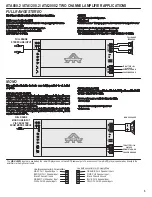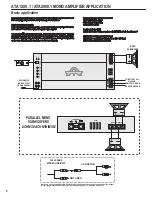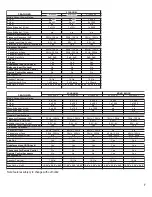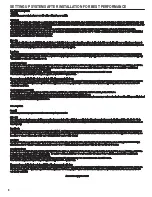
TROUBLESHOOTING A SYSTEM
9
The key to finding the problem in a misbehaving sound system is to isolate parts of that system in a logical fashion to track down the fault.
Description of the PROTECT system built into all Autotek amplifiers
Amplifier heatsink overheating
Low output power
Fuses blowing
System does not turn on
The diagnostic system will shut down the amplifier, until reset by turning the head unit off, and back on. This state of affairs will be indicated by the front panel PROTECT
LED lighting up under the following conditions:
1 -Asort circuit on the loudspeaker leads.
2 -An internal amplifier fault that causes a DC offset on the loudspeaker output.
Should the amplifier go into protect mode, simply disconnect all RCAand speaker leads, while k12 volt, power ground and remote leads connected.
1. Now turn the amplifier back on, and if the diagnostic LED lights, the amplifier has an internal fault.
2. If not, plug the RCAcables back, and reset the amplifier. If it goes into diagnostic now, the fault lies in the input, either with bad cables or source unit.
3. If the amplifier seems fine with RCA cables plugged in, connect the speakers, one at a time, and if one of the speakers or its wiring is faulty, it will activate the diagnostic
system.
The amplifiers will shut down when the heatsink temperature reaches 80 degrees centigrade, and turn back on once the unit has cooled down below that point.
1 - Inadequate cooling - relocate or remount to provide better natural airflow over the fins.
2 - Driving high power levels into low impedances - back off on the volume control, and/or make sure you are not loading the amplifier with less than the recommended
loudspeaker impedance.
1 - Check that level controls have been set up properly.
2 - Make sure that the battery voltage, as measured at the amplifier
’
s +12 volt and ground terminals, is 11 volts or more.
3 - Check all +12 volt and ground connections.
1 - The use of loudspeaker impedances below the recommended minimums will draw more current - check.
2 -Ashort on the main +12 volt cable from the battery to the vehicle chassis will cause the main fuse to blow.
3 - If an amplifier fuse blows continually, with only +12 volt, ground and remote leads connected, the amplifier may be faulty.
1 - Check all fuses.
2 - Check all connections.
3 - Measure the +12 volt and remote turn on voltages at the amplifier terminals. If these are non existent or low, take voltage measurements at fuse holders, distribution
blocks, the head unit
’
s +12 volt and remote leads to localize the problem.
Causes of overheating:
Noise problems
Hiss, or white noise
Electrical interference
System noise can be divided into two categories, hiss, and electrical interference.
1 - High levels of white noise usually occurs when amplifier level controls are turned up too high - readjust according to the procedures in section
2 -Another major problem that can cause excessive hiss, is a noisy head unit - unplug the amplifier input RCAcables, and if the hiss level reduces, the source unit is at fault.
The inside of an automobile is a very hostile electrical environment. The multitude of electrical systems, such as the ignition system, alternator, fuel pumps, air conditioners,
to mention just a few, create radiated electrical fields, as well as noise on the +12 volt supply and ground. Remember to isolate the problem - first unplug amplifier input RCA
cables, if the noise is still present, check the speaker leads, if not, plug the RCA
’
s back, and investigate the source driving the amplifier, one component at a time.
1 - This problem could be caused by radiation pickup of RCAcables too near to a fuel pump or a distributor, for instance, - relocate cables.
2 - Check that the head unit ground is connected straight to the vehicle chassis, and does not use factory wiring for ground.
3 - Try to supply the head unit with a clean +12 volt supply directly from the b, instead of using a supply from the in dash wiring/fusebox.
This type of noise can be more difficult to pinpoint, but is usually caused by some kind of instability, causing oscillations in the system.
1 - Check all connections, especially for good grounds.
2 - Make sure that no speaker leads are shorting to exposed metal on the vehicle chassis.
3 -RCAcables are notorious for their problematic nature, so check that these are good, in particular the shield connections.
”Setting up systems after
installation for best performance”
A ticking or whine that changes with engine RPM:
A constant whine:
We have also provided several videos that will help you with your battery,
alternator and even Big 3 upgrades at www.youtube.com/maxxsonicsusainc .
Summary of Contents for 2050.4
Page 13: ......































